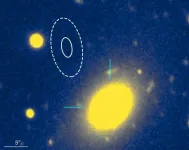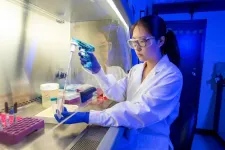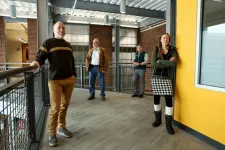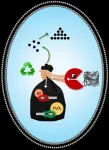(Press-News.org) Astronomer Calvin Leung was excited last summer to crunch data from a newly commissioned radio telescope to precisely pinpoint the origin of repeated bursts of intense radio waves — so-called fast radio bursts (FRBs) — emanating from somewhere in the northern constellation Ursa Minor.
Leung, a Miller Postdoctoral Fellowship recipient at the University of California, Berkeley, hopes eventually to understand the origins of these mysterious bursts and use them as probes to trace the large-scale structure of the universe, a key to its origin and evolution. He had written most of the computer code that allowed him and his colleagues to combine data from several telescopes to triangulate the position of a burst to within a hair's width at arm's length.
The excitement turned to perplexity when his collaborators on the Canadian Hydrogen Intensity Mapping Experiment (CHIME) turned optical telescopes on the spot and discovered that the source was in the distant outskirts of a long-dead elliptical galaxy that by all rights should not contain the kind of star thought to produce these bursts.
Instead of finding an expected "magnetar" — a highly magnetized, spinning neutron star left over from the core collapse of a young, massive star — "now the question was: How are you going to explain the presence of a magnetar inside this old, dead galaxy?" Leung said.
The young stellar remnants that theorists think produce these millisecond bursts of radio waves should have disappeared long ago in the 11.3-billion-year-old galaxy, located 2 billion light years from Earth and weighing more than 100 billion times the mass of the sun.
“This is not only the first FRB to be found outside a dead galaxy, but compared to all other FRBs, it’s also the farthest from the galaxy it’s associated with. The FRB’s location is surprising and raises questions about how such energetic events can occur in regions where no new stars are forming,” said Vishwangi Shah, a doctoral student at McGill University in Montreal, Canada, who refined and extended Leung's initial calculations about the location of the burst, called FRB 20240209A.
Shah is the corresponding author of a study of the FRB published today (Tuesday, Jan. 21) in the Astrophysical Journal Letters along with a second paper by colleagues at Northwestern University in Evanston, Illinois. Leung, a co-author of both papers, is a lead developer of three companion telescopes — so-called outriggers — to the original CHIME radio array located near Penticton, British Columbia. He mentored Shah at McGill while Leung was a doctoral student at the Massachusetts Institute of Technology (MIT) and subsequently held an Einstein Postdoctoral Fellowship at UC Berkeley prior to his Miller fellowship.
New CHIME outrigger in California
A third outrigger radio array will go online this week at Hat Creek Observatory, a facility in Northern California formerly owned and operated by UC Berkeley and now managed by the SETI Institute in Mountain View. Together, the four arrays will immensely improve CHIME's ability to precisely locate FRBs.
"When paired with the three outriggers, we should be able to accurately pinpoint one FRB a day to its galaxy, which is substantial," Leung said. "That's 20 times better than CHIME, with two outrigger arrays."
With this new precision, optical telescopes can pivot to identify the type of star groups — globular clusters, spiral galaxies — that produce the bursts and hopefully identify the stellar source. Of the 5,000 or so sources detected to date — over 95% of which were detected by CHIME — few have been isolated to a specific galaxy, which has hindered efforts to confirm whether magnetars or any other type of star are the source.
As detailed in the new paper, Shah averaged many bursts from the repeating FRB to improve the pinpointing accuracy provided by the CHIME array and one outrigger array in British Columbia. After its discovery in February 2024, astronomers recorded 21 more bursts through July 31. Since the paper was submitted, Shion Andrew at MIT incorporated data from a second outrigger at the Green Bank Observatory in West Virginia to confirm Shah's published position with 20 times the precision.
“This result challenges existing theories that tie FRB origins to phenomena in star-forming galaxies,” said Shah. “The source could be in a globular cluster, a dense region of old, dead stars outside the galaxy. If confirmed, it would make FRB 20240209A only the second FRB linked to a globular cluster.”
She noted, however, that the other FRB originating in a globular cluster was associated with a live galaxy, not an old elliptical in which star formation ceased billions of years ago.
“It's clear that there's still a lot of exciting discovery space when it comes to FRBs and that their environments could hold the key to unlocking their secrets,” said Tarraneh Eftekhari, who has an Einstein Postdoctoral Fellowship at Northwestern and first author of the second paper.
"CHIME and its outrigger telescopes will let us do astrometry at a level unmatched by the Hubble Space Telescope or the James Webb Space Telescope. It'll be up to them to drill down to find the source," Leung added. "It's an amazing radio telescope."
The studies were supported by Gordon and Betty Moore Foundation, NASA, the Space Telescope Science Institute, the National Science Foundation, the David and Lucile Packard Foundation, the Alfred P. Sloan Foundation, the Research Corporation for Science Advancement, the Canadian Institute for Advanced Research, the Natural Sciences and Engineering Council of Canada, the Canada Foundation for Innovation and the Trottier Space Institute at McGill.
END
Astronomers thought they understood fast radio bursts. A recent one calls that into question.
The new ability to pinpoint sources of fast radio bursts places one recent burst in a surprising location.
2025-01-21
ELSE PRESS RELEASES FROM THIS DATE:
AAAS announces addition of Journal of EMDR Practice and Research to Science Partner Journal program
2025-01-21
Journal of EMDR Practice and Research (JEMDR), launched in 2007, is devoted to integrative, state-of-the-art papers about EMDR therapy. It is a broadly conceived interdisciplinary journal that stimulates and communicates research and theory about EMDR therapy and its application to clinical practice. The journal publishes articles on all aspects of EMDR therapy and Adaptive Information Processing (AIP) theory. JEMDR is co-lead by Jenny Ann Rydberg, MA, PhdD cand. (University of Lorraine, Nancy, France) and Derek Farrell, PhD, MBE (Northumbria, Newcastle-upon-Tyne, UK).
As a member of the Science Partner Journal program, JEMDR will publish on a continuous basis under ...
Study of deadly dog cancer reveals new clues for improved treatment
2025-01-21
Researchers at the University of Florida College of Veterinary Medicine and the UF Health Cancer Center have identified a crucial link between a gene mutation and immune system signaling in canine hemangiosarcoma, a discovery that could lead to better treatments for both dogs and humans with similar cancers.
The research focuses on hemangiosarcoma, an aggressive cancer that forms malignant blood vessels in dogs. This life-threatening condition is difficult to diagnose early, as tumors can grow silently before rupturing without warning, leading to emergencies. ...
Skin-penetrating nematodes have a love-hate relationship with carbon dioxide
2025-01-21
Key takeaways
Globally, over 600 million people are infected with the skin-penetrating threadworm, Strongyloides stercoralis, mostly in tropical and subtropical regions with poor sanitation infrastructure.
Infections are treated with ivermectin, but some nematodes are starting to develop resistance to this first-line drug.
UCLA biologists have discovered that the nematodes respond differently to carbon dioxide at different stages in their life cycle, which could help scientists find ways to prevent or cure infections by targeting ...
Fewer than 1% of U.S. clinical drug trials enroll pregnant participants, study finds
2025-01-21
PROVIDENCE, R.I. [Brown University] — A new study by researchers from the Brown University School of Public Health found that pregnant women are regularly excluded from clinical drug trials that test for safety, raising concerns for the efficacy of these medications for maternal and child health.
The study, published in the American Journal of Obstetrics and Gynecology, analyzed 90,860 drug trials involving women ages 18 to 45 from the past 15 years and found that only 0.8% included pregnant participants. ...
A global majority trusts scientists, wants them to have greater role in policymaking, study finds
2025-01-21
In what is considered the most comprehensive post-pandemic survey of trust in scientists, researchers have found a majority of people around the world carry widespread trust in scientists — believing them to be honest, competent, qualified and concerned with public well-being.
Researchers surveyed more than 72,000 individuals across 68 countries on perceptions of scientists’ trustworthiness, competence, openness and research priorities.
The results, published in the journal Nature Human Behavior, also showed the general public’s desire ...
Transforming China’s food system: Healthy diets lead the way
2025-01-21
According to the study published in Nature Food, China’s current trajectory is misaligned with the United Nations Sustainable Development Goals (SDGs). The researchers assessed potential pathways for achieving the SDGs in China by transforming its food system, focusing on dietary changes, climate change mitigation, ecological conservation, and socio-economic development. “Action across all areas of the food system is required to achieve a sustainable food system and efficiently address the wide range of social and environmental ...
Time to boost cancer vaccine work, declare UK researchers
2025-01-21
UK oncology researchers have come together to write the first ever national thought leadership strategy report into cancer vaccine advances and the opportunities these present for those affected by cancer. The strategy report has been published in Cambridge University Press journal Cambridge Prisms: Precision Medicine.
Cancer vaccines hold the potential to revolutionise cancer treatment. These vaccines leverage neoantigens to activate the immune system against tumours, offering a personalised approach to combat cancer. This transformative potential is particularly significant in light of recent advancements in oncology, including ...
Colorado State receives $326M from DOE/EPA to improve oil and gas operations and reduce methane emissions
2025-01-21
The Department of Energy and Environmental Protection Agency have awarded $326 million to three Colorado State University research projects that aim to improve U.S. oil and gas operations and reduce methane emissions nationwide.
The EPA’s Methane Emissions Reduction Program is providing the funding to the CSU Energy Institute and faculty working across multiple departments in the Walter Scott, Jr. College of Engineering, with the goal of helping oil and gas operators improve operational efficiency and manage emissions. The efforts will also support activity to build an inventory of methane emissions, ...
Research assesses how infertility treatments can affect family and work relationships
2025-01-21
Infertility is a problem that affects between 8% and 12% of couples of reproductive age worldwide – for some of them, the problem interrupts a life project, which is the desire to have children and build a family. Advances in technology and medicine have made assisted reproductive treatments possible, but they can be physically and psychologically draining for the couples involved, especially because of expectations of results that may not be achieved.
The emotional impact of treatment is well documented in the scientific literature. ...
New findings shed light on cell health: Key insights into the recycling process inside cells
2025-01-21
A recent study from Tata Institute of Fundamental Research, Mumbai, India has revealed new details about how our cells clean up and recycle waste. This process, known as autophagy, is like a self-cleaning mechanism for cells, helping the cells stay healthy by getting rid of damaged parts and recycling useful components. The process involves formation of a vesicle called autophagosome, which encapsulates the cellular waste. The autophagosome then fuses with another type of vesicle called lysosome. ...
LAST 30 PRESS RELEASES:
Subnational income inequality revealed: Regional successes may hold key to addressing widening gap globally
Protein puppeteer pulls muscle stem cells’ strings
Study: A genetic variant may be the reason why some children with myocarditis develop heart failure, which could be fatal
Social justice should not be tokenistic but at the heart of global restoration efforts
A new kind of copper from the research reactor
Making simulations more accurate than ever with deep learning
Better predicting the lifespan of clean energy equipment, towards a more efficient design
Five ways microplastics may harm your brain
Antibody halts triple-negative breast cancer in preclinical models
Planned birth at term reduces pre-eclampsia in those at high risk
Penguins starved to death en masse, study warns, as some populations off South Africa estimated to have fallen 95% in just eight years
New research explains how our brains store and change memories
Space shuttle lessons: Backtracks can create breakthroughs
New study finds cystic fibrosis drug allows patients to safely scale back lung therapies
From field to lab: Rice study reveals how people with vision loss judge approaching vehicles
Study highlights underrecognized link between kidney disease and cognitive decline
Researchers find link between psychosocial stress and early signs of heart inflammation in women
Research spotlight: How long-acting injectable treatment could transform care for postpartum women with HIV
Preempting a flesh-eating fly’s return to California
Software platform helps users find the best hearing protection
Clean hydrogen breakthrough: Chemical lopping technology with Dr. Muhammad Aziz (full webinar)
Understanding emerges: MBL scientists visualize the creation of condensates
Discovery could give investigators a new tool in death investigations
Ultrasonic pest control to protect beehives
PFAS mixture disrupts normal placental development which is important for a healthy pregnancy
How sound moves on Mars
Increasing plant diversity in agricultural grasslands boosts yields, reducing reliance on fertilizer
Scientists uncover a new role for DNA loops in repairing genetic damage
AI chatbots can effectively sway voters – in either direction
Study reveals 'levers' driving the political persuasiveness of AI chatbots
[Press-News.org] Astronomers thought they understood fast radio bursts. A recent one calls that into question.The new ability to pinpoint sources of fast radio bursts places one recent burst in a surprising location.



